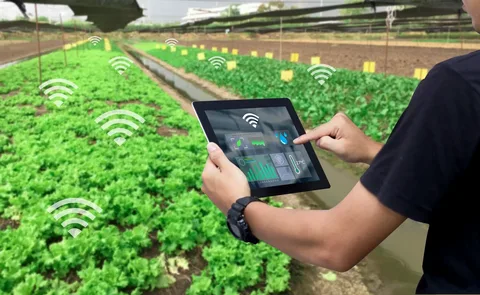The world of agriculture is experiencing a significant transformation, driven by technological advancements. Among these, the Internet of Things (IoT) stands out as a game-changer. How IoT is Revolutionizing smart agriculture is no longer just a question—it is a reality reshaping the way farmers manage crops, livestock, and resources efficiently.
Understanding IoT in Agriculture
The Internet of Things (IoT) refers to a network of interconnected devices that can collect, share, and analyze data. In agriculture, these devices include sensors, drones, smart irrigation systems, and automated machinery. By leveraging IoT technology, farmers can gain real-time insights into soil conditions, crop health, weather patterns, and livestock monitoring.
Enhancing Crop Management
One of the most significant ways IoT is revolutionizing smart agriculture is through precision farming. IoT sensors can measure soil moisture, nutrient levels, and temperature to provide actionable data. This allows farmers to optimize irrigation schedules, apply fertilizers efficiently, and prevent crop diseases before they escalate. The result is higher yields, reduced waste, and sustainable farming practices.
Livestock Monitoring and Management
IoT is not limited to crops; it also plays a crucial role in livestock management. Wearable devices and smart collars can track animal health, activity, and location in real-time. By monitoring vital signs and behavior patterns, farmers can detect illnesses early and ensure the well-being of their livestock. This integration demonstrates how IoT is revolutionizing smart agriculture beyond the farm fields.
Water and Resource Efficiency
Water scarcity is a pressing issue in agriculture, and IoT solutions help address it efficiently. Smart irrigation systems connected to IoT sensors can automatically adjust water supply based on soil moisture levels and weather forecasts. This precise water management conserves resources while maintaining optimal crop growth, highlighting another dimension of how IoT is revolutionizing smart agriculture.
Challenges and Future Outlook
Despite its benefits, IoT adoption in agriculture faces challenges such as high initial costs, connectivity issues in rural areas, and the need for technical expertise. However, as technology becomes more accessible and affordable, the adoption rate is expected to rise, leading to smarter, more sustainable farming practices.
Conclusion
The integration of IoT in agriculture is no longer a futuristic idea—it is actively transforming the farming industry. From precision crop management to livestock monitoring and resource optimization, how IoT is revolutionizing smart agriculture is evident in every corner of modern farms. As IoT technology continues to evolve, the future of agriculture promises increased efficiency, sustainability, and productivity.


